Armstrong-Whitworth F.K.8
Mid Production Version
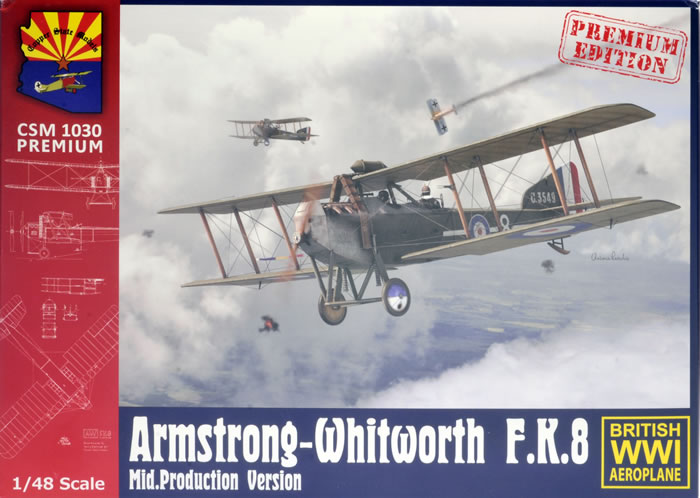
Copper State Models, 1/48 scale
S
u m m a r y : |
Description and Item No.: |
Copper State Models Kit No. #1030 - Armstrong-Whitworth F.K.8 Mid Production Version. Premium Edition |
Contents and Media: |
104 parts in medium grey coloured plastic; two parts printed onto clear acetate sheet; 15 resin parts; hollow metal exhausts; around 95 photo-etched parts on three frets; markings for four aircraft. |
Price: |
Outside Europe Price - 54.00 EUR
Europe Price - 65.34 EUR
plus shipping available online from Copper State Models' website |
Scale: |
1/48 |
Review Type: |
First Look |
Advantages: |
High level of detail; beautifully appropriate surface textures including stretched fabric, stitching and stringers; clever engineering including integrated turnbuckles / rigging mounts / strut locations for the wings; well illustrated and logically laid out instruction booklet including rigging guide. |
Disadvantages: |
Photo-etched bending, struts and rigging will suit the more experienced WWI modeller. |
Recommendation: |
This is another gem of a kit from Copper State Models. Detail is excellent, moulding quality is first class, parts breakdown is straightforward, the instructions are a joy and the whole package exudes quality.
Compared to their last two releases, the A-W F.K.8 falls somewhere between the Dolphin and the Caudron in terms of degree of difficulty. The basic construction looks free from complication and the struts, although there are quite a few of them, have been engineered with robust locating pins and holes. Rigging and folding the photo-etched nose parts will probably be the greatest challenge.
I can't wait to see what Copper State has in store for us next time!
Highly Recommended. |
Reviewed by Brett Green

G.W.H.s 1/48 scale T-33A Shooting Star will be available online from Squadron.com
The Armstrong Whitworth F.K.8 was a British two-seat general-purpose biplane built by Armstrong Whitworth during the First World War.
The aircraft, originally designated the F.K.7, was designed by Dutch aircraft designer Frederick Koolhoven as a replacement for the Royal Aircraft Factory B.E.2c and the Armstrong Whitworth F.K.3. It was a sturdier aircraft than the F.K.3, with a larger fuselage and wings, and was powered by a 160 hp (110 kW) Beardmore water-cooled engine.
The undercarriage used oleo shock absorbers and the observer was equipped with a Scarff ring mounting for a .303 in (7.7 mm) Lewis machine gun. No armament was initially provided for the pilot. The rudder featured a long, pointed horn-balance.
The type had several teething troubles: the oleo undercarriage was unable to withstand rough use on the front line airfields, tail skids frequently broke and the original radiators blocked up quickly.
Following instructions issued on 30 April 1917, some F.K.8s were refitted with simplified vee-undercarriages from Bristol F.2 Fighters. This soon led to a temporary shortage of these undercarriages and the practice had to be discontinued until May 1918, after which several F.K.8s were fitted with revised undercarriages.
Most production F.K.8s had modifications to the wings, gunner's seat and the exhaust system. The tall inverted vee radiators incorporated improved tubes which reduced the blockages. On later aircraft the nose cowling was redesigned and smaller box radiators were standardised.
In service the F.K.8 (nicknamed the "Big Ack") proved to be effective and dependable, being used for reconnaissance, artillery spotting, ground-attack, contact-patrol and day and night bombing.
It was reputedly easier to fly than the R.E.8 and was sturdier but its performance was even more pedestrian and it shared the inherent stability of the Royal Aircraft Factory types. While the pilot and observer were placed reasonably close together, communication between the two lacked the "tap on the shoulder" intimacy of the Bristol Fighter (or the R.E.8 for that matter).
The first squadron to take the type to France was 35 Squadron RFC, in January 1917. The type eventually served with several squadrons on operations in France, Macedonia, Palestine and for home defence, proving more popular in service than its better known contemporary the R.E.8.
The F.K.8 was principally used for corps reconnaissance but was also used for light bombing, being capable of carrying up to six 40 lb (20 kg) phosphorus smoke bombs, up to four 65 lb (29 kg) bombs or two 112 lb (51 kg) bombs on underwing racks.
The type served alongside the better known R.E.8 until the end of the war, at which point 694 F.K.8s remained on RAF charge.
Eight aircraft were civil-registered after the war with two aircraft being used in Australia by the Queensland and Northern Territory Aerial Services (later QANTAS)*
*Background information adapted from Wikipedia
Copper State Models
Copper State Models was originally an American cottage industry manufacturer of WWI aircraft kits and accessories. Its models were generally a multimedia mix of resin and white metal parts.
A recent change of ownership has led to a change in direction. Still focused on WWI subjects, the company is now revisiting the Copper State Models back catalogue and restoring the kits.
They have also launched the first two in a series of all-new injection moulded plastic models.

Here is how the new Copper State Models describe themselves on their website:
"We are group of WWI scale modelling enthusiasts from two continents and six countries united by common interests and hobby. We produce the finest quality World War One aeroplane multimedia resin kits in 1:48 and aftermarket accessories in 1:72, 1:48, 1:32, and 1:28 scales. Our high-quality 1:48 scale multimedia kits contain resin, and NiAg Photo-Etch (PE) parts, and include decals for the appropriate colour schemes. Some of the kits include WM parts. When documentation exists for interior details they will be provided for you, but please note that some minor parts may need to be made from scratch (such as tailskids, control sticks etc.). Most of our kits will be the first time these aircraft have been produced in 1:48 scale.
Since we took over the CSM from the founder Mr Eric R. Hight of Phoenix, Arizona who is still an inspiration to us, we have sent all master kits for the restoration. Unfortunately two 1/48 master kits were run down completely and to be re-built from the scratch.
Please note that all of us at CSM have daytime jobs and families.
The Copper State Models SIA. as company registered in Latvia (EU)."
Copper State Models' first injection moulded plastic kit was a 1/48 scale Sopwith 5F.1 Dolphin, released in May of 2016, followed by a Caudron G.IV. These were a gorgeous kits with excellent detail, appropriate use of multimedia, lovely surface textures and a relatively straightforward subject.
Copper State continues its commitment to interesting but underexposed WWI subjects with this new 1/48 scale Armstrong-Whitworth F.K.8 reconnaissance and bomber aircraft.
Copper State Models' 1/48 scale Armstrong-Whitworth F.K.8 comprises a modest 104 parts in medium grey plastic, 15 resin parts, hollow metal exhausts, two parts printed onto clear acetate sheet, around 95 photo-etched parts on three frets and markings for four aircraft.
The quality of moulding is excellent with no flash and narrow sprue attachment points.
Surface textures are restrained. The fabric effect is beautifully done, being subtly stretched on the wings, fuselage and tail surfaces.
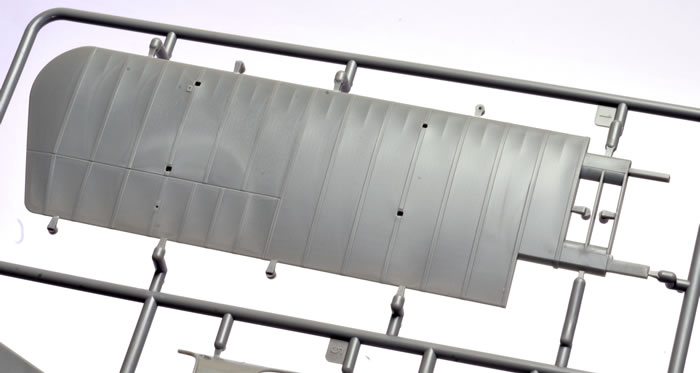
Plenty of detail is supplied for the front and rear cockpits using plastic and photo-etched parts. Structural detail in the form of framework is moulded to the inside of the fuselage. The windscreens are provided as printed actetate parts that will need to be cut from the clear sheet.

The upper wing is supplied as a full-span single part, while the lower wing is one part per side.
There are deep, crisp locating holes in the wings for the eight interplane struts. In a common with their previous releases, Copper State supplies flower-like photo-etched locating points for the rigging. These are glued to the locating holes in the wings, which are then glued to the struts.
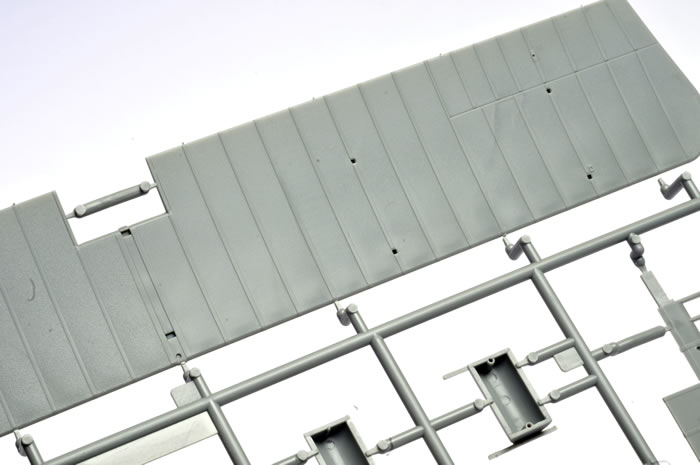
The three photo-ecthed frets provide stacks of extra detail parts for the interior and exterior of the model.

In fact, the engine cowlings and nose are all photo-etched parts, so get practicing with your PE bending tools! Copper State has wisely supplied two spare nose pieces in case of problems. There is another piece of challenging folding required - a narrow intake tube. I'll be replacing this with a piece of appropriately sized copper or plastic tube.

In this Premium package we are supplied with a jewel-like resin engine that features separate cylinder housings, exhaust manifold and more.
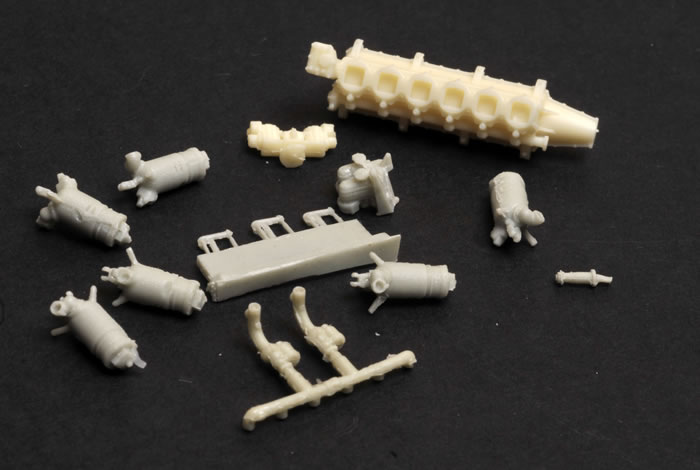
The Premium Edition also includes a beautiful one-piece pressed-metal hollow exhaust. It is reminiscent of the Moskit exhausts of old.
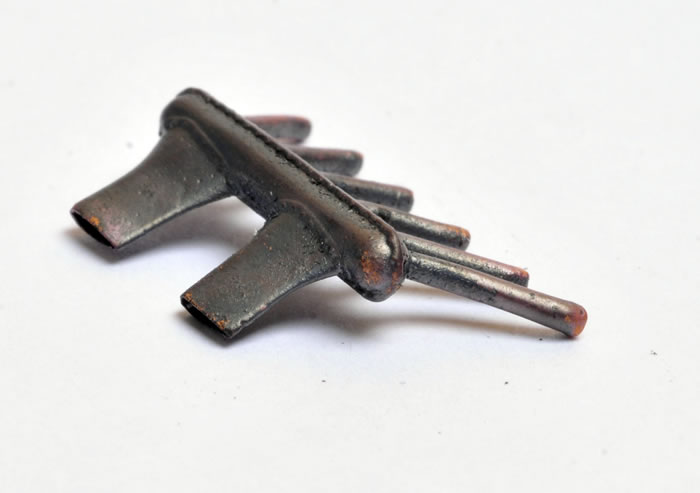
The instructions are presented very much in the style of Wingnut Wings - clear, concise colour keyed illustrations broken down into steps of assembly and painting. Colour callouts are made throughout.

The rigging diagram is also in the style of Wingnut Wings.
Markings
Markings are supplied for four RFC machines. All four are finished in PC10 on the uppers and Clear Doped Linen on the lower surfaces.
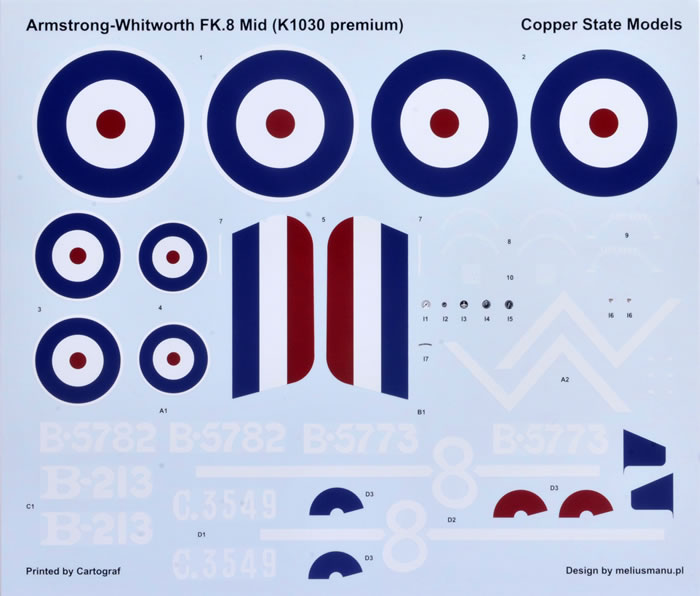
The decals are well printed and in register, but unlike the previous two releases, these are flat in finish. They have been produced by Cartograf.
This is another gem of a kit from Copper State Models. Detail is excellent, moulding quality is first class, parts breakdown is straightforward, the instructions are a joy and the whole package exudes quality.
Compared to their previous two releases, the A-W F.K.8 falls somewhere between the Dolphin and the Caudron in terms of degree of difficulty.
The basic construction looks free from complication and the struts, although there are quite a few of them, have been engineered with robust locating pins and holes. Rigging and folding the photo-etched nose parts will probably be the greatest challenge.
I can't wait to see what Copper State has in store for us next time!
Highly Recommended.
Thanks to Copper State Models for the sample
*Historical background courtesy of Wikipedia
Review Text and Images Copyright © 2017 by Brett Green
Page Created 18 May, 2017
Last updated
19 May, 2017
Back to HyperScale Main Page
Back to Reviews Page

|
Home
| What's New |
Features |
Gallery |
Reviews |
Reference |
Forum |
Search